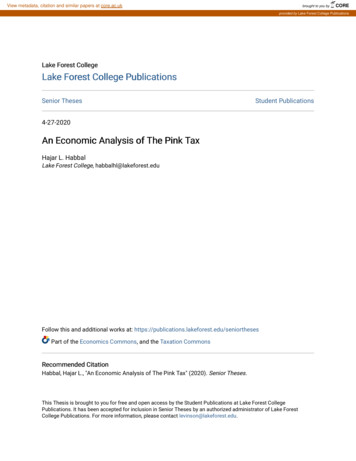
Transcription
View metadata, citation and similar papers at core.ac.ukbrought to you byCOREprovided by Lake Forest College PublicationsLake Forest CollegeLake Forest College PublicationsSenior ThesesStudent Publications4-27-2020An Economic Analysis of The Pink TaxHajar L. HabbalLake Forest College, habbalhl@lakeforest.eduFollow this and additional works at: rt of the Economics Commons, and the Taxation CommonsRecommended CitationHabbal, Hajar L., "An Economic Analysis of The Pink Tax" (2020). Senior Theses.This Thesis is brought to you for free and open access by the Student Publications at Lake Forest CollegePublications. It has been accepted for inclusion in Senior Theses by an authorized administrator of Lake ForestCollege Publications. For more information, please contact levinson@lakeforest.edu.
An Economic Analysis of The Pink TaxAbstractThe “Pink Tax” broadly refers to firm pricing strategies and/or government policies that raise transactionalcosts (usually higher taxes or higher prices) for women. Conversations about the Pink Tax have beensteadily growing over the past several decades; people have conflicting views on its existence, causes,and implications, to the point that there are substantive questions regarding its validity. More research isneeded to determine where exactly the Pink Tax comes from and what are its true effects. For those whoargue that the Pink Tax exists and is detrimental to females, a leading explanation for the transmissionmechanism is through the propagation of gender socialization trough marketing strategies. Due to thelack of government data that allow for direct measurement of the Pink Tax, this study provides ananalysis of consumers’ exposure to marketing. Specifically, this study correlates gender, age, race, maritalstatus, and marijuana use (to proxy for preferences for certain types of behavior) with marketingexposure, to offer support for the claim that the Pink Tax benefits from this transmission mechanism. Thefindings demonstrate there is a strong inverse relationship between education and marketing exposure,measured by hours spent watching television in a week as a teenager.Document TypeThesisDegree NameBachelor of Arts (BA)Department or ProgramEconomics, Business, and FinanceFirst AdvisorRobert J. LemkeSecond AdvisorAmanda J. FelkeyThird AdvisorSusan M. LongSubject CategoriesEconomics TaxationThis thesis is available at Lake Forest College Publications: 63
LAKE FOREST COLLEGESenior ThesisAn Economic Analysis of The Pink TaxbyHajar L. HabbalApril 27, 2020The report of the investigation undertaken as aSenior Thesis, to carry two courses of credit inthe Department of Economics, Business, and FinanceDavis SchneidermanKrebs Provost and Dean of the FacultyRobert J. Lemke, ChairpersonAmanda J. FelkeySusan M. LongElizabeth BenackaPatricia Thomas
AbstractThe “Pink Tax” broadly refers to firm pricing strategies and/or governmentpolicies that raise transactional costs (usually higher taxes or higher prices) for women.Conversations about the Pink Tax have been steadily growing over the past severaldecades; people have conflicting views on its existence, causes, and implications, to thepoint that there are substantive questions regarding its validity. More research is neededto determine where exactly the Pink Tax comes from and what are its true effects. Forthose who argue that the Pink Tax exists and is detrimental to females, a leadingexplanation for the transmission mechanism is through the propagation of gendersocialization trough marketing strategies. Due to the lack of government data that allowfor direct measurement of the Pink Tax, this study provides an analysis of consumers’exposure to marketing. Specifically, this study correlates gender, age, race, marital status,and marijuana use (to proxy for preferences for certain types of behavior) with marketingexposure, to offer support for the claim that the Pink Tax benefits from this transmissionmechanism. The findings demonstrate there is a strong inverse relationship betweeneducation and marketing exposure, measured by hours spent watching television in aweek as a teenager.
To my sister whose anger about razor prices fueled my passion for the subjectand to my parents for pushing me to achieve my dreams.
AcknowledgmentsI wish to acknowledge the support and great love of my family, my mom, Touria; mydad, Omar; and my sister, Dahlia. They kept me going on and this work would not havebeen possible without their support.I would like to thank my academic and thesis advisor, Professor Robert Lemke, for histime, help, and encouragement over the course of my college career. Being my biggestsupporter at Lake Forest College, I am grateful for his continuous mentorship. Thanksalso to my committee members for their comments, support, and advice, not only for mysenior thesis, but for much more.I would also like to thank my friends who have listened to me talk about the Pink Tax forthe past 10 months and who have accompanied me on numerous sleepless nights at thelibrary.Lastly, I would like to thank the institution of Lake Forest College. Without itsimpeccable education and its marvelous professors, my dreams of writing a thesis on asubject that deeply mattered to me would have not been honored. Thank you Lake ForestCollege for giving me this chance. I will always be a Forester Forever.
Table of ContentsI. Introduction 1II. Gender Socialization . 2III. Gender-Based Price Discrimination . . 8IV. The Tampon Tax . . . 12V. Specific Examples of the Pink Tax . . 18VI. The National Longitudinal Survey of Youth, 1979 . 32VII. The Econometric Model . . 35VIII. Regression Results . 37XI. Policy Prescriptions . 41X. Conclusion . . 51References .53Appendix: Visual Examples of the Pink Tax 59
I.IntroductionGender-based price discrimination is a form of economic discrimination thatoccurs when one gender is charged a different price than the other for identical (or nearlyidentical) products or services. Within the sphere of gender-based price discrimination,the “Pink Tax” refers to the extra charges placed on products and services that areessentially identical but are marketed separately to men and women (e.g., the pricedifference between a “male” and “female” deodorant). The name, the Pink Tax, stemsfrom the historical prevalence of products being marketed to women having a tendency tobe pink in color. The Pink Tax manifests itself in two ways. First, certain products orservices bear an additional tax to the price. Second, which is not literally a tax, firms sellproducts marketed to women at a higher price than they sell (nearly identical) productsmarketed to men. In this second case, firms are not charging higher prices on femaleproducts out of malice but are following a profit-maximizing strategy that capitalizes onmarket trends, preferences, shopping behavior, and psychology. Even though a literal taxis not in place, many women feel compelled to pay these higher prices for a variety ofreasons. Thus, when the market bears higher prices on “female” products, therefore, afinancial burden is being placed on women that is not placed on men, epitomizing socialgender-stereotypical norms whether the firm’s discriminatory pricing is intentional ornot.1
II.Gender SocializationThe Pink Tax arises from the pressure of following stereotypical gender norms inorder to fit in society (Smith, 2007). The appropriate term here is called “gendersocialization.” Gender socialization is the process by which people learn how they“should” act based on their sex. To be specific, gender socialization starts with thestipulations that biological sex determines an individual's masculine or feminine identity.Gender applies to the facets of self that are non-physiological in nature. For the purposeof this paper, gender will be defined in the traditional sense of being binary (women arefemales and men are males) as opposed to the more recent convention of gender being ona continuum. Granting that an individual's gender is not independent of his or her sex,gender varies by the culture someone lives in. As such, gender can vary from one cultureto another, which is extensively seen through the process of gender socialization (Smith,2007). Gender socialization then refers to how society intentionally and unintentionallyteaches rules, norms and expectations for both sexes. According to UNICEF (2017),gender socialization can be compartmentalized into three different groups of influencelevels: structural (e.g. socio-economic conditions), social-interactional (e.g. family) andindividual (e.g. biologically). Figure 1 provides a visual description of the entire processof gender socialization working through these three levels.Structural influences of gender socialization manifest through socio-economicconditions, gender/patriarchal structures, political structures, social structures (like raceand class), or global media (John, Stoebenau, Ritter, Edmeades & Balvin, 2017). Despitethe complexity of the relationship between the different factors affecting the process ofgender socialization, it has been demonstrated that, among the predictors, socio-economic2
conditions and patriarchal structures strongly affect this process at the macro-level.Patriarchy is a social system in which, generally speaking, men hold much more powerthan women in all aspects of society, including inside households, at work, and inpolitics. Consequently men, rather than women, are bestowed political leadershippositions, moral authority, social privilege, and property ownership (Sultana, 2010). Thisrelationship at the macro-level necessarily correlates human development and genderequality at the country level (Hausmann, 2014). For instance, the human developmentindex (HDI) is a cross-country measure of human well-being within a country, taking intoaccount economics, health, education, human rights, etc. The UNICEF report (2017)shows that countries with high levels of HDI are typically associated with more genderequality compared to countries with low levels of HDI. In terms of women’s well-being,higher HDI implies countries with a high human development index (HDI)1 are shown tobe more gender-equal, which is measured as having good reproductive health,opportunities for gender empowerment, and greater labor market participation forwomen, (e.g. Norway, Switzerland, Germany) compared to countries with lower levels ofHDI that don’t afford women these benefits (e.g. Niger, Chad, South Sudan).However, as direct as this correlation may seem, socio-economic developmentand gender equality do not necessarily move lock step together. Sometimes, based ongeographic location and geopolitical context, countries with a fairly high HDI can havelow gender equality levels (e.g. Iran, Egypt). That is, the political landscape also dictateshow gender socialization manifests itself. If women and men do not have equal access to1The Human Development Index measures life expectancy, employment, and per capita incomein order to rank and divide countries into four tiers of human development.3
opportunity, a distinction between genders will almost certainly be perpetuated. Aswomen increase their role in male-dominated areas, such as politics and traditional maledominated industries like law and finance, a platform for women to be more vocal and toseek the recognition that they deserve is created. That platform also provides thenecessary tools for adolescent girls to have same-sex role models further their owndevelopment and advancement (Slaby & Frey, 1975). The same goes for womenportrayed in public media. The more often women are represented as existing outsidetheir typical gender, the more readily girls will break from stereotypes and contest thegender socialization process that is ever-present in current society (Koenig, 2018). Theshift away from women’s traditional role in the household to powerful women in theworkforce gives even more importance to those women holding professional careers(Smith, 2007).The social interactional influences of gender socialization that perpetuate genderstereotypes are family, neighbors, schools, social networks and peers. According toseveral studies, children use gender categorization (male or female) to focus theirattention on same-gender role models (Martin & Ruble, 2004). They observe and absorbthe behaviors of those models and figure out the differences in behavior betweenone gender and the other. Learning from these models, children are more likely to exhibitthe same behaviors of the role models they identify with, and in so doing, form a strongidea of what their gender “can” and “cannot” do. Moreover, when these stereotypes areperpetuated by model agents like parents, peers, teachers, and figures in the media,children become even more rigid about their belief (Martin & Ruble, 2004).4
The last level of influence in the gender socialization process is at the individuallevel. Humans are all different biologically, physically, cognitively, and personality-wise.Because of individual differences, humans are taught to act differently towards each otherin a continuous cycle. If a person is a woman, she will be treated differently than if shewas a man. From that difference at the individual level, many stereotypes, created by theprocess of gender socialization, are perpetuated and affect how one is treated. Evenbefore a baby is born, caregivers may feel the need to appropriate a certain color pallet tothe gender of the infant. Paoletti (2012) makes the argument that this particularconstruction – pink is for girls and blue is for boys – is a fairly recent construct. Prior tothe 20th century, white was the popular color for children's clothes since it was simpler toclean and wash. However, the introduction of a gendered color pallet escalated in the1980s. Paoletti observes that that the demand for (or, at least consumption of), genderspecific baby clothing arose as a result of people wanting to learn the sex of their babybefore the birth, which became possible in the 1980s when such tests became affordable.With parents learning whether they were having a girl or a boy, they became moreinclined to decorate the nursery long in advance with the "appropriate" color, blue forboys and pink for girls, and toys (Paoletti, 2012). Manufacturers and designers tookadvantage of the market and offered parents a greater opportunity to “identify” they babyas a baby girl or as a baby boy by offering gendered products for newborns, includingclothing, toys, crib bedding, wallpaper, and even baby shampoo. All of this productmarketing and consumption behavior perpetuates gender socialization (Paoletti, 1987).Additionally, after birth, the child is exposed to many terms and symbols thatshape their conception of gender roles and stereotypes. Stereotypes, although associated5
to a negative connotation, are very useful to navigate the world. Categorizing people intoboxes based on similarities can help humans organize their thoughts and make the worlda less confusing place. The stereotypes children encounter can be seen through thelanguage people use to describe or talk to a child, in person or portrayed through themedia. For example, parents (and family, friends, neighbors, and the media) oftendescribe boys through their physical characteristics, strength and agility, while girls areassessed through the concepts of beauty, fragility and emotions (Smith, 2007).Furthermore, one flagrant way children are differentiated by gender is through the toysadvertised to them. Even though some parents have adapted to the changing society andpush their child to explore different toys based on their likes and not society’s pressure,the world still has a long way to go. It is truly important for model agents to understandthe impact of their behaviors and suggestions near children because beliefs about genderare formed at a very young age.Through one’s developmental cycle, gender socialization is continuouslyperpetuated in everyday life situations. For example, women are expected to look prettyand put together. Throughout the 20th century to the present, society has told women thatthey had to wear makeup and be “presentable” in the workplace. Even with women’sadvancement in more powerful positions in the last 30 years (e.g., in banking, the law,medicine, etc.), society still expects women to look and dress a certain way in order to betaken seriously and on par with their male colleagues (Dellinger & Williams, 1997).Presently, this phenomenon is often discussed on blogs and in online forums all acrossthe world, because while women feel the pressure to appear visually pleasing, they alsorecognize the extreme cost to do so. Even having to purchasing a basic drugstore6
eyeshadow and mascara in order to be presentable is an expectation, and an additionalcost, that is not expected of men. The cheapest eyeshadow and mascara at a localWalgreens cost 1.09 and 1.99 respectively; with taxes, this comes to 3.33 in LakeCounty, IL. And, makeup is only one of the countless “requirements” for a women’ssocial acceptability in the workplace. A professional women will need to have her hairdone, wear a professional pair of shoes, wear designer clothes, and own elegant jewelryin order to even be welcomed into some professions, not to say anything about what itmay take to earn promotions or gain power (Dellinger & Williams, 1997). Obviously,every decade has its own stereotypical trends, and women were not always required towear makeup, however, in the 21st century, they are (Zosuls, Miller, Ruble, Martin, &Fabes, 2011). Overall, gender stereotypes are cultivated/promoted and carried throughoutsociety, through gender socialization, which results in the Pink Tax.At the three different levels of influence mentioned previously, there are forcesthat affect a certain gender more than another, which can lead to negative economicimpacts. At the structural level, there are gender-based differences in education, theworkforce, socio-political participation, and reproductive health regulations. At thesocial-interactional level, gender socialization may manifest itself in marital violence andchild marriage. Lastly, at the individual level, gender socialization affects women andmen by cultivating different attitudes, beliefs, skills and behaviors across the genders. Inthis way, gender socialization creates the basis for an unseen bias or expectation beingplaced on a gender. Specifically, these outcomes of gender socialization in the 21stcentury continue to perpetuate the foundation of a gender-based price discrimination, alsoknown as the Pink Tax.7
III.Gender-Based Price DiscriminationIn order to eventually discuss gender-based price discrimination, we must firstdiscuss price discrimination in general.Price discrimination occurs when identical or nearly identical goods and servicesare priced differently to different sets of consumers, and the price differences cannot beattributed to differences in production costs such as transportation costs. For example,charging higher prices in Hawaii than in California for avocados grown in California isnot price discrimination as long as the transportation cost accounts for the additionalprice charged in Hawaii. On the other hand, McDonalds charging senior citizens 0.79for a coffee but charging 1.09 for the same coffee bought by anyone else is pricediscrimination.Price discrimination is a selling tactic that firms use to maximize their profit.When consumer groups are identifiable, with each group having different averagepreferences or a different budget or a different willingness to pay for a product, charginga menu of different prices allows the firm to segregate the market into smaller markets,and ultimately charge the profit maximizing price in each market rather than choosing asingle price across all markets.To be technical, when consumer purchase a good or service, except for themarginal buyer, each consumer would have been willing to pay even more at the point ofpurchase. The difference between one’s willingness to pay and the actual price paid istermed the consumer’s surplus. Summing each consumer’s surplus across the entiremarket is called “Total Consumer Surplus” by economists. (As a side note, graphicallytotal consumer surplus is the area under the demand curve and above the market price).8
Consumer surplus is an important concept for economists as it represents the value of themarket to consumers (Liston-Heyes & Neokleous, 2000).Now, turning attention to price discrimination, the idea is simply that by chargingdifferent groups of consumers a different price, the firm can capture some of theconsumer surplus. That is, price discrimination is a way to extract more money fromconsumers and to increase firm profits. Price discrimination is pursued whenever theprofit gained by creating segmented markets is greater than the profit earned from sellingto a single market. Thus, price discrimination is only effective if (1) different consumergroups are identifiable, and (2) if the groups vary systematically in their willingness topay for the good, and (3) the high value group maintains relatively inelastic demand forthe good so that they are willing to pay the higher prices. Consumers tend to pay a higherprice in a fairly inelastic submarket, while consumers in a fairly elastic submarket pay alower price. Linking this to gender socialization is straightforward. The process of gendersocialization tells women that women are supposed to look, dress, and act a certain way,and that as a woman, you should not ignore these social norms. The immediateconsequence, therefore, is that women, taken on average as an identifiable group separatefrom men, have highly inelastic demand for the “necessities” of life in a society thatdictates particular behavior.Economics and the law distinguish between three degrees of price discrimination:perfect-price pricing (1st degree), bulk pricing (2nd degree), and target market pricing (3rddegree). First degree price discrimination tracks each consumer’s demand curveperfectly, as each consumer is charged their willingness to pay. In this sense, first degreeprice discrimination is demand-based since it depends on the willingness-to-pay of9
consumers (Ferrel, Kapelianis, Ferrell & Rowland, 2018). As first degree pricediscrimination occurs when a firm sells its product at the maximum price possible foreach unit consumed, first degree price discrimination allows the firm to capture allconsumer surplus and maximize firm profits. A key feature of first-degree pricediscrimination, therefore, is that the firm negotiates price with each individual consumer.For example, at a souk, consumers can bid on a product and sellers might be over-pricingit, but the consumer will only pay the maximum they are willing to spend. Pure firstdegree price discrimination is rare in the marketplace, because most goods are not soexpensive as to afford the firm the ability to assign resources to the negotiation process.Second degree price discrimination occurs when prices are based on the amountpurchased (i.e., buying in bulk). This form of price discrimination happens more oftenthan first degree price discrimination and can regularly be seen at wholesale markets likeCostco Wholesale Corporation, Home Depot, and even at grocery stores where per unitprices are frequently lower when buying a larger container.Third degree price discrimination, which is the most relevant to the Pink Tax,occurs when a firm charges different prices to different identifiable groups of consumers.Such identifiable traits could be gender, location, or age. The idea, as stated earlier, is thatfirms will want to engage in third degree price discrimination whenever the identifiablegroups have a different willingness to pay and a different demand elasticity for the good(Listen-Heyes & Neokleous, 2000). Examples of third-degree price discrimination runrampant. Transportation companies offer discounts to both senior citizens and to students.Airlines charge different prices for round trips that include a Saturday night stay(presumably indicative of leisure travel) and trips that are started and completed within10
the same work week (presumably indicative of business travel that is paid for byemployers). Many professional sports franchises charge lower ticket prices to veterans.Each of these examples are readily observable in the marketplace.The Pink Tax, however, is a much more nefarious examples of third-degree pricediscrimination. Gender socialization leads society to value gender differences, whetherreal or not. Therefore, although Proctor and Gamble or Johnson & Johnson doesn’tcharge one price to women and one price to men for an identical product, the result ofgender socialization is that companies like this can sell nearly identical products, butmarketed to women and men differently, and ultimately be able to charge different pricesto different segments of society. Thus, third degree price discrimination can be used todescribe clothing, toys, health care products, and other markets where products marketedto women or girls or baby girls cost more than nearly identical products marketed to menor boys or baby boys. Although much more difficult to identify, this type of gender-basedpricing is a form of third-degree price discrimination and is called gender-based pricediscrimination.Gender-based price discrimination is difficult to identify, and firms andpoliticians frequently argue against its existence. A firm can easily claim that apparently“nearly identical” products are, in fact, not nearly identical in the manufacturing process.For example, a textile firm that sells nearly identical t-shirts at different prices can claima difference in pattern or cut or style contributes to an additional cost incurred by the firmwhich then justifies charging higher prices for female products. Similarly, a health careproducts company can argue that the addition of a perfume to a women’s deodorantjustifies a higher price, or even a toy manufacturer can argue that the difference in color11
of a children’s bicycle took more time or money to produce. Moreover, these argumentsmight even withstand the scrutiny of a court of law when firms are required to “open theirbooks” to investigators, because firms still control the conversation about what drivesparticular costs.Ultimately, though, one of the strongest indicators of the Pink Tax is that, even ifthere are some legitimate costs that drive up the price of some products marketed towardwomen, there is no reason to expect the costs to always be higher for women. But this iswhat careful scrutiny of the market shows. Gender-based price discrimination unjustlyexists when almost all markets that target different products for women and men chargehigher prices for the women products. This could not legitimately be the case if higherprices were always indicative of higher production costs alone.As unfair and unjust gender-based price discrimination is, directly taxing womenfor their gender is even more abrasive to women as it is a visible attack on being awoman. This happens when governments intentionally tax products that are uniquelyutilized by women for biological purposes: feminine hygiene products. This is known asthe tampon tax, and it is taken up in the next section.IV.The Tampon TaxWithin the realm of the Pink Tax exists the Tampon Tax. The “Tampon tax” is apopular term used to describe tampons and other feminine hygiene products that aresubject to VAT (value-added tax) or sales tax, unlike the status of tax exemption given toother items considered necessities. Tax exemption supporters argue that tampons,sanitary napkins, menstrual cups and similar items are essential items that are12
unavoidable for women and should therefore be tax exempt. Advocates argue thatwomen’s hygiene products necessary to the hygiene of menstrual cycle should becategorized along with other essential, tax-exempt needs, such as food and personalmedical products. There are no necessary product needing a tax exemption for men,including condoms, that could be comparable to female hygiene products becausemenstruation is biological and “feminine hygiene is not a choice.” Given that biologicalfemales are the vast majority of buyers of feminine hygiene products, the increased costpaid by women because such products are not tax exempt is criticized as discriminatoryagainst women.In 2004, the government of Kenya led the way by taking the position thatfeminine hygiene products are a necessity, and they eliminated the Tampon Tax. Morethan a decade passed before any other country followed suit. In 2015, after an onlinepetition signed by thousands made its way to parliament, Canada also exempted theseproducts from taxation. And in 2018, India abolished its 12 percent tax on femininehygiene products. In the case of India, change came about following to years of activismfrom advocacy groups and celebrities. Superstar actor Akshlay Kumar starred in Pad Manas the leading male actor and raised awareness for the Niine Movement.2 In Colombia,the Constitutional Court unanimously ruled in November 2018 that its 5 percent tax ontampons and pads, on grounds of gender equality, would be abolished. After 18 years ofcampaigning, Australia abolished its 10 percent tax on feminine hygiene products2The Niine Movement was introduced as an audacious five-year campaign to engage and educatepeople of all sexes and ages to address the stigma associated with menstruati
Publications. It has been accepted for inclusion in Senior Theses by an authorized administrator of Lake Forest College Publications. For more information, please contact levinson@lakeforest.edu. View metadata, citation and similar papers at core.ac.uk brought to you by CORE provided by Lake Forest College Publications. Lake Forest College .










